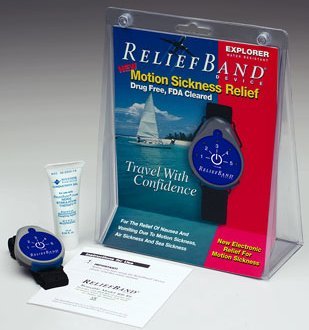- Home
- Interesting Articles
- ReliefBand: Best Remedy Yet For Motion Sickness
ReliefBand: Best Remedy Yet For Motion Sickness
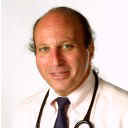 Whatever euphemism you use -- puking, urping, barfing, power yawn -- motion sickness is a huge problem for aviation. It's a common reason for student pilots to quit, a major impediment to aerobatic training, and such a serious problem for passengers that many pilots can't coax spouses or children to fly with them. In this interview, AVweb's aeromedical expert Dr. Brent Blue talks about what causes motion sickness and discusses the various drug and non-drug remedies available, including a just-released electronic device that looks like it might be the best answer yet.
Whatever euphemism you use -- puking, urping, barfing, power yawn -- motion sickness is a huge problem for aviation. It's a common reason for student pilots to quit, a major impediment to aerobatic training, and such a serious problem for passengers that many pilots can't coax spouses or children to fly with them. In this interview, AVweb's aeromedical expert Dr. Brent Blue talks about what causes motion sickness and discusses the various drug and non-drug remedies available, including a just-released electronic device that looks like it might be the best answer yet.
by Brent Blue, M.D. (brent.blue@aeromedix.com), Senior Aviation Medical Examiner
This article originally appeared in AVweb, the Internet's aviation magazine and news service, and is reprinted here by permission.
RELIEFBAND UPDATE: Woodside Biomedical has now discontinued its disposable non-prescription models. The only non-prescription model presently available is the Model RB-EL "Explorer" which features replaceable batteries and a water-resistant case. This model is ideal for pilots, boaters, frequent flyers, pregnant women suffering from "morning sickness," or anyone susceptible to any sort of nausea and vomiting. It works equally well for air sickness, seasickness, and car sickness. Woodside also offers two prescription models that are FDA-cleared for the relief of nausea and vomiting from chemotherapy or anesthesia. One has replaceable batteries, while the other is a 144-hour disposable. The prescription models are slightly stronger than the non-prescription models, and may be eligible for medical insurance reimbursement The reusable models uses two standard CR-2025 3-volt lithium coin cells available at any Radio Shack, or online from OceanMedix.com. The company also stocks extra tubes of conductive gel . |
 What is motion sickness? Different textbooks have different definitions, but basically motion sickness -- also called air sickness, sea sickness or car sickness -- is nausea and vomiting triggered by disturbance of the vestibular apparatus. The vestibular apparatus refers to the semicircular canals of the inner ear which we use to maintain balance and sense orientation and movement.
What is motion sickness? Different textbooks have different definitions, but basically motion sickness -- also called air sickness, sea sickness or car sickness -- is nausea and vomiting triggered by disturbance of the vestibular apparatus. The vestibular apparatus refers to the semicircular canals of the inner ear which we use to maintain balance and sense orientation and movement.
One theory of motion sickness focuses on sensory conflict. Cruise ship passengers are far more likely to get seasick when below because their vestibular sense detects motion while their eyes reveal motionless surroundings. The standard advice for seasickness is to get up on deck where visual input agrees with vestibular input. Likewise, studies have shown that a child is far less likely to experience car sickness when in an elevated child seat that provides a good outside view.
Air sickness is more problematic, however. An outside view doesn't necessarily help in aviation, because flight constantly presents sensory conflicts. During a coordinated turn, for example, our eyes show a tilted horizon while our vestibular sense says we're perfectly upright. Uncoordinated maneuvers and turbulence provide even more complex conflicts. In a cloud, we may receive all sorts of vestibular sensations while our eyes report a featureless, horizonless void.
Motion sickness produces a whole range of symptoms, of which nausea and vomiting are the most severe. Actually, symptoms generally follow a path of increasing severity. Early indications of motion sickness onset may include headache, increased salivation and swallowing, eructation (a nice medical word for belching and burping), flatulence (same idea, different orifice), pallor and cold sweats. The victim may then develop nausea -- which is defined as the sensation associated with anticipation of vomiting -- and ultimately may experience emesis (the medical term for vomiting) or retching (unproductive vomiting movements).
Abrupt vomiting can occur without other symptoms, but this is mainly experienced in space flight and other zero-G situations. Normally, the victim has a fair amount of advance warning.
Pilots often report that their family members and other passengers are far more prone to motion sickness than they are. There are at least two separate reasons for this. First, pilots and drivers tend to experience motion sickness far less often than passengers. Going back to the sensory-conflict theory, we think that motion sickness is triggered by discrepancies between anticipated orientation and actual orientation. If you're at the controls of the airplane (or boat or car), you tend to know what's coming and this seems to confer a certain amount of immunity. Being in control of how long the flight will last and having the ability to end it at will is also an important factor in relieving the anxiety that contributes to motion sickness.
Motion sickness is also a learned malady which can be unlearned. Roughly 17 percent of military pilot-trainees experience motion sickness serious enough to interfere with aircraft control, but only about 1 percent actually wash out due to air sickness. The rest simply learn to deal with the sensory conflicts through accustomization. The same is true of aerobatic pilots: Almost everyone experiences symptoms of motion sickness on first exposure to high-G maneuvers, but those who stick with it tend to develop more tolerance over time.
Motion Sickness Remedies
A number of medications have been used to combat motion sickness with various degrees of success. It may take some experimentation to find a drug or combination of drugs that are effective for a particular individual.
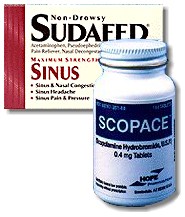 There are two combinations that I've found to be moderately effective in combating motion sickness. One is Phenergan (promethazine hydrochloride) 25-50 mg combined with Sudafed (ephedrine) 25-50 mg. The other choice is a combination of dextroamphetamine 5 mg and scopolamine .5 mg, although it might be harder to talk your family doctor into prescribing these since dextroamphetamine is a frequently-abused drug. Either of these combinations should be taken one hour before flight.
There are two combinations that I've found to be moderately effective in combating motion sickness. One is Phenergan (promethazine hydrochloride) 25-50 mg combined with Sudafed (ephedrine) 25-50 mg. The other choice is a combination of dextroamphetamine 5 mg and scopolamine .5 mg, although it might be harder to talk your family doctor into prescribing these since dextroamphetamine is a frequently-abused drug. Either of these combinations should be taken one hour before flight.
Another effective medication which recently returned to the market is the scopolamine patch (Transderm Scop). The patch looks like a spot bandage and is generally worn behind the ear. It should be applied eight hours before flight and can be worn up to three days, but cannot be removed and reapplied. Scopolamine is now also available in time-release capsule form. Side effects include sedation and dialation of the pupils (which can affect vision and force the user to wear sunglasses).
Other drugs that have been used for motion sickness include antipsychotics such as Compazine (prochlorperazine), antihistamines such as Dramamine (dimenhydrinate), and various antiemetic agents used for suppressing the side effects of chemotherapy.
All the meds mentioned so far are available by prescription only.
Over-the-counter remedies available without prescription include Dramamine, Marezine and Bonine. These are very weak antihistimines and work through sedation (to the extent that they work at all).
 None of these drugs -- whether prescription or OTC -- are legal for pilots. Such medications can only be used by passengers or student pilots. The FAA will not issue a medical certificate to pilots who require medication to control airsickness. Furthermore, almost all medications used for motion sickness have side effects on the central nervous system that are absolute no-nos as far as the FAA is concerned. Aerobatic pilots may use anti-nausea drugs while taking instruction (provided the instructor has agreed to be PIC), but they'll have to be drug-free by the time they graduate to solo aerobatics.
None of these drugs -- whether prescription or OTC -- are legal for pilots. Such medications can only be used by passengers or student pilots. The FAA will not issue a medical certificate to pilots who require medication to control airsickness. Furthermore, almost all medications used for motion sickness have side effects on the central nervous system that are absolute no-nos as far as the FAA is concerned. Aerobatic pilots may use anti-nausea drugs while taking instruction (provided the instructor has agreed to be PIC), but they'll have to be drug-free by the time they graduate to solo aerobatics.
There is one over-the-counter "drug" which has no systemic effect and is therefore okay in the FAA's eyes. It's called Emetrol (phosphorated carbohydrates) and comes as a sweet syrup. It is a formula based on the traditional use of Coke syrup as a nausea treatment (back in the days when soda fountains actually used the stuff). Dosage is one teaspoon per hour, and some people find it helpful.
 There are also some non-drug remedies that have been used with varying degrees of success (and, if you're a pilot, with the FAA's blessing). One involves the use of ginger powder (from the grocery store) loaded into gelatin capsules and taken before flight. Ginger turns out to be a natural anti-emetic.
There are also some non-drug remedies that have been used with varying degrees of success (and, if you're a pilot, with the FAA's blessing). One involves the use of ginger powder (from the grocery store) loaded into gelatin capsules and taken before flight. Ginger turns out to be a natural anti-emetic.
An interesting one I learned about last year was to eat a bagel just before flight. Several instructors gave testimonials asserting that this is a surefire remedy. There's actually some medical basis for this, as eating a bagel would be similar to taking Emetrol -- a carbohydrate. On the other hand, there are no real controlled studies of such non-traditional remedies, and whatever effectiveness they have may be due to placebo effect.
Biofeedback has been proven quite effective in the military, but involves time and costly equipment. Basically, the pilot or passenger is placed in a "spin chair" after being hooked up to biofeedback sensors. They're then spun to the point of vertigo and nausea while attempting to use biofeedback techniques to remain warm and dry instead of cold and clammy. The technique is a method for speeding up the accustomization process. One Air Force study placed pilots in biofeedback two hours a day for two weeks, and reported that 79 percent were able to return to flying duties.
 Acupuncture is another unconventional treatment that has been shown effective by scientific studies in the suppression of nausea and vomiting. Acupuncture needles are applied to the inside of the wrist to stimulate the median nerve. This stimulation seems to block the nausea reflex for reasons which are still not entirely clear. Obviously, this is a procedure that is more practical in a clinical setting than as a remedy for air or sea sickness.
Acupuncture is another unconventional treatment that has been shown effective by scientific studies in the suppression of nausea and vomiting. Acupuncture needles are applied to the inside of the wrist to stimulate the median nerve. This stimulation seems to block the nausea reflex for reasons which are still not entirely clear. Obviously, this is a procedure that is more practical in a clinical setting than as a remedy for air or sea sickness.
So-called "acupressure bands" have started appearing in pilot shops and catalogs. These are elastic bands with protrusions that apply pressure to the wrist, supposedly to stimulate the median nerve in the fashion of acupuncture. While some people claim they work, I am not aware of any studies to show that anything more than placebo effect is involved.
The ReliefBand®
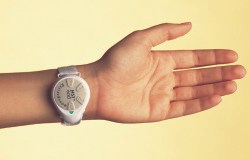 The success of acupuncture as an anti-nausea treatment led to the development of a device called the ReliefBand which has just come onto the market. I had the opportunity to test a prototype of this device during 1997 and 1998 with a number of patients, and it sure looks to me like the best method yet for the relief of nausea and vomiting. I've used the ReliefBand very successfully to treat airsickness. I've also used it to relieve the nausea and vomiting associated with chemotherapy and pregnancy, both of which have been major problems in the past.
The success of acupuncture as an anti-nausea treatment led to the development of a device called the ReliefBand which has just come onto the market. I had the opportunity to test a prototype of this device during 1997 and 1998 with a number of patients, and it sure looks to me like the best method yet for the relief of nausea and vomiting. I've used the ReliefBand very successfully to treat airsickness. I've also used it to relieve the nausea and vomiting associated with chemotherapy and pregnancy, both of which have been major problems in the past.
Cancer patients don't like the available anti-nausea medications because they either don't work well or are so sedating that the patients cannot function while taking them. The ReliefBand suppresses nausea and vomiting with no sedative side effects, and it even works on "anticipatory nausea" of chemotherapy on which meds do not work at all.
Hyperemesis Gravidarum is the medical term for the intractable vomiting associated with pregnancy, colloquially referred to as "morning sickness." It's a huge problem for physicians because you really don't want pregnant patients taking anti-nausea medications due to the possible effects on the baby. I've found the ReliefBand to be highly effective in this application, too.
 The ReliefBand looks like a plastic wristwatch with an elastic band, but is worn on the inside of the wrist and electrically stimulates the median nerve. The manufacturer, Woodside Biomedical, refers to the technique as "Nerve Stimulation Technology" (NST), but it's basically an adaptation of Transcutaneous Electrical Nerve Stimulation (TENS), which has been used in the medical community for pain control for many years.
The ReliefBand looks like a plastic wristwatch with an elastic band, but is worn on the inside of the wrist and electrically stimulates the median nerve. The manufacturer, Woodside Biomedical, refers to the technique as "Nerve Stimulation Technology" (NST), but it's basically an adaptation of Transcutaneous Electrical Nerve Stimulation (TENS), which has been used in the medical community for pain control for many years.
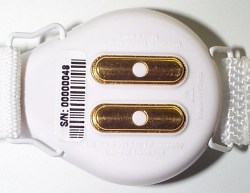 The ReliefBand weighs 1.2 ounces and contains electronics plus a pair of coin-size lithium batteries. The underside of the device has a pair of gold-plated electrodes that contact the skin. To use the device, the wrist is first cleaned with an alcohol swab, after which a small dab of conductive gel is applied to the skin (same stuff that's used when you take an EKG). The ReliefBand is positioned so that its electrodes are between the two tendons on the inside of the wrist, about an inch from the skin crease between the wrist and palm. This places them above the median nerve.
The ReliefBand weighs 1.2 ounces and contains electronics plus a pair of coin-size lithium batteries. The underside of the device has a pair of gold-plated electrodes that contact the skin. To use the device, the wrist is first cleaned with an alcohol swab, after which a small dab of conductive gel is applied to the skin (same stuff that's used when you take an EKG). The ReliefBand is positioned so that its electrodes are between the two tendons on the inside of the wrist, about an inch from the skin crease between the wrist and palm. This places them above the median nerve.
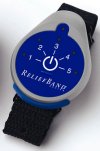 The face of the ReliefBand has a dial that permits the device to be turned on and off and adjusted to any of five stimulation levels. The face of the unit clearly displays the selected intensity, labeled 1 through 5. The face also has a two-color LED that blinks green to verify the unit is working, changing to red when the batteries are within eight hours of becoming exhausted.
The face of the ReliefBand has a dial that permits the device to be turned on and off and adjusted to any of five stimulation levels. The face of the unit clearly displays the selected intensity, labeled 1 through 5. The face also has a two-color LED that blinks green to verify the unit is working, changing to red when the batteries are within eight hours of becoming exhausted.
Upon the first signs of distress, the wearer turns the device on and adjusts the dial until a mild tingling sensation is felt. For maximum battery life, the unit should be adjusted to the lowest setting that provides the desired relief.
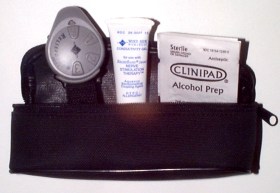 Nominal battery life is 144 hours at the medium-intensity setting, after which the batteries can be easily replaced. The ReliefBand uses two standard CR-2025 coin cells, available from Aeromedix.com or from any Radio Shack or other store that sells wristwatch batteries.
Nominal battery life is 144 hours at the medium-intensity setting, after which the batteries can be easily replaced. The ReliefBand uses two standard CR-2025 coin cells, available from Aeromedix.com or from any Radio Shack or other store that sells wristwatch batteries.
The ReliefBand comes with a 10cc tube of conductive gel. OceanMedix.com sells extra tubes of the gel, replacement batteries, and a zippered black Cordura carrying case that provides room for one or two ReliefBands plus gel, and spare batteries.
Yes, But Does It Really Work?
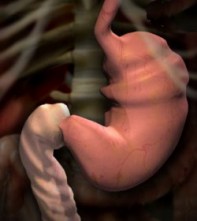 |
 |
The ReliefBand has undergone extensive clinical trials in the control of nausea and vomiting. It is presently FDA-approved as a treatment for nausea in chemotherapy patients, for the control of "morning sickness" in pregnant women, and for relief of motion sickness. FDA approval is also expected shortly for relief of post-anesthesia nausea in surgical patients.
In addition to the clinical trials required for FDA approval, some interesting laboratory studies have also been documented. One study involved instrumenting patients' abdomens with electrodes (in a test procedure similar to an EKG or EEG) that permit observation of stomach muscle contractions. Normally, the stomach muscles exhibit a slow, rhythmic, involuntary motion (called peristalsis) which gradually propels the gastric contents downward through the gastrointestinal tract. It turns out that when patients experience nausea, the stomach muscles almost always exhibit an abnormal, rapid, erratic action. Consequently, abdominal electrodes provide researchers with an objective measurement of the condition that is subjectively described as nausea. The study in question showed clearly that electrical stimulation of the median nerve of the wrist was highly effective in suppressing nausea and restoring the normal peristaltic rhythm of the stomach muscles.
Since the ReliefBand was originally developed for clinical use, there are relatively few studies to date on its use in controlling motion sickness.
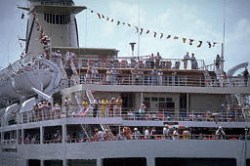 Perhaps the best-documented of these was conducted with the cooperation of a major cruise ship line in May 1997, during a cruise from New York to Bermuda and back. Sea conditions during that cruise were moderate to rough, and many of the 1,268 passengers suffered so badly from sea sickness that they were unable to eat or participate in shipboard activities. 171 of the passengers who came to the ship's hospital seeking relief were given prototype ReliefBands to wear, and were asked to fill out a questionnaire at the end of the cruise. Among other things, they were asked to "score" their nausea on a scale from 1 to 5 (where 1 denoted no nausea and 5 denoted constant nausea and vomiting).
Perhaps the best-documented of these was conducted with the cooperation of a major cruise ship line in May 1997, during a cruise from New York to Bermuda and back. Sea conditions during that cruise were moderate to rough, and many of the 1,268 passengers suffered so badly from sea sickness that they were unable to eat or participate in shipboard activities. 171 of the passengers who came to the ship's hospital seeking relief were given prototype ReliefBands to wear, and were asked to fill out a questionnaire at the end of the cruise. Among other things, they were asked to "score" their nausea on a scale from 1 to 5 (where 1 denoted no nausea and 5 denoted constant nausea and vomiting).
Average nausea scores dropped from 4.0 on the first day (before the ReliefBands were dispensed) to 1.5 and 1.3 on the final days of the cruise. Fully 96 percent of the responses to the question "Would you recommend the use of the RelifBand device to another potential passenger?" were in the affirmative.
Many of the passenger comments submitted with the questionnaires were also revealing: "Worked wonders." "I had taken two different kinds of pills and had a shot, but nothing worked until your bracelet." "Got instant relief." "Removed after dinner; became nauseous; replaced ReliefBand; nausea went away within 10-15 minutes." "Was like a miracle." "When I took it off in rough seas, I would feel ill and put it back on; within 10 minutes, was relieved." "An amazing thing."
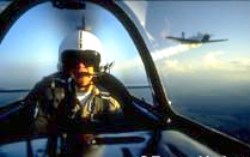 I participated in an informal study in 1997 at Texas Air Aces, an air combat program that flies T-34s out of Hooks Field in Houston. The test involved 40 missions, each involving two T-34 aircraft, each of which was flown by a student and an instructor. Roughly 80% of the students were not certificated pilots, so their level of accustomization was low. For each mission, one of the students wore a ReliefBand while the other student was given a placebo. Among the non-ReliefBand group, 15 of the 40 (38%) vomited during the mission, while among the students who used the ReliefBand, only 4 (10%) vomited. Statistically, this is a huge difference.
I participated in an informal study in 1997 at Texas Air Aces, an air combat program that flies T-34s out of Hooks Field in Houston. The test involved 40 missions, each involving two T-34 aircraft, each of which was flown by a student and an instructor. Roughly 80% of the students were not certificated pilots, so their level of accustomization was low. For each mission, one of the students wore a ReliefBand while the other student was given a placebo. Among the non-ReliefBand group, 15 of the 40 (38%) vomited during the mission, while among the students who used the ReliefBand, only 4 (10%) vomited. Statistically, this is a huge difference.
I have prescribed the ReliefBand to a number of other pilots and received uniformly positive reports. One of those pilots was Doug Ritter, contributing editor for Aviation Consumer and former AVweb news editor, who wrote:
"The device simply eliminated any discomfort in every one of those who tried it at my request, including myself. No other anti-nausea treatment comes even close to that rate of efficacy, and there are no adverse side effects either. It is also the only treatment I've ever seen that helped to cure or significantly reduce motion sickness symptoms even after they started. If air sickness is preventing you from enjoying flying to its utmost, or preventing your family from sharing your enjoyment, you owe it to yourself to try the ReliefBand. I think you will be amazed at the result."
 If you have any other questions about motion sickness, the ReliefBand, or other motion sickness treatments, feel free to drop me an email at brent.blue@aeromedix.com and I'll do my best to answer them.
If you have any other questions about motion sickness, the ReliefBand, or other motion sickness treatments, feel free to drop me an email at brent.blue@aeromedix.com and I'll do my best to answer them.
 Loading... Please wait...
Loading... Please wait...

